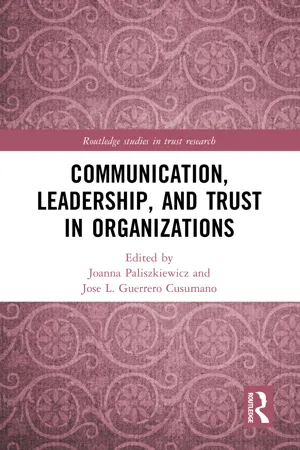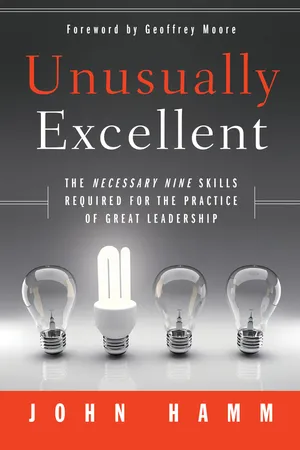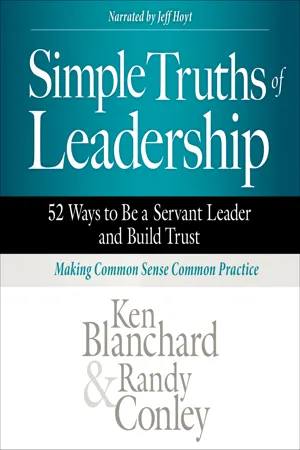Business
Leadership Trust
Leadership trust refers to the confidence and reliance that employees have in their leaders. It is built on transparency, consistency, and integrity in decision-making and actions. When leaders are trusted, it fosters a positive work environment, enhances employee engagement, and ultimately contributes to the success of the organization.
Written by Perlego with AI-assistance
Related key terms
Related key terms
1 of 4
Related key terms
1 of 3
10 Key excerpts on "Leadership Trust"
- Joanna Paliszkiewicz, José L. Guerrero Cusumano(Authors)
- 2023(Publication Date)
- Routledge(Publisher)
Transactional leadership is also related to trust, but in a slightly different way than transformational leadership. In transactional leadership, trust is built on the exchange of rewards and punishments for achieving desired goals. The leader sets clear expectations and rewards followers for meeting those expectations while also punishing or correcting them for falling short. Trust is built through the consistency and transparency of this exchange, with followers believing that the leader will follow through on promises and remain fair in their dealings. However, this form of trust is more focused on the leader's ability to provide tangible rewards and punishments rather than on building personal relationships or inspiring followers to achieve their potential, as in transformational leadership.6.4 Discussion
Trust is extremely important in management, and it is a concept that is receiving more attention from both professionals and scholars. Trust helps take risks and use resources effectively and impacts all aspects of an organization. However, trust is not automatic and requires effort and actions to establish. Developing trust within an organization is a crucial aspect of effective management.Leadership and trust go hand in hand, and leaders must build trust with their subordinates to achieve their goals. According to Bracey (2002 ), a leader can establish interpersonal trust by following five principles: transparency, responsiveness, care for others, sincerity, and trustworthiness. Similarly, Butler (1991 ) highlights essential qualities that a leader must possess to build trust with their subordinates, such as availability, competence, consistency, discretion, honesty, loyalty, openness, fairness, keeping promises, and transparency. According to Sprenger (2004 ), trust can be built through reliability, coherence, predictability, keeping promises, honesty, loyalty, discretion, and credibility. Armour's idea (2007 ) emphasizes that people should focus on four key elements: climate, character, behavior, and culture. Leaders must first create a climate of trust so that employees feel safe, informed, respected, valued, and understood (SIRVU model). Trust will develop if employees see the following traits in leaders (HI-TRUST model): humility, integrity, truth, responsiveness, unblemished fair play, support and encouragement, and team care. Bibb and Kourdi (2004- Gerard P. Hodgkinson, J. Kevin Ford(Authors)
- 2011(Publication Date)
- Wiley(Publisher)
To be able to exert such influence effectively and without the need for constant monitoring or for forceful coercion, trust between leaders and followers seems crucial. The GLOBE study, which focused on cultural differences in implicit leadership theories, suggests several trust-related qualities universally endorsed as important for leaders; for example, in all 60 countries involved in this study, an outstanding leader was expected to be a confidence builder, good at team building and communicating, who is decisive and intelligent as well as trustworthy, just, and honest (Den Hartog, House, Hanges, et al., 1999; House, Hanges, Hanges, et al., 2004). Trust in leaders has positive effects within organizations. For example, in a study of restaurants, Davis, Schoorman, Mayer, et al. (2000) found that employees’ trust in the general manager of their restaurant was related to improved financial performance and reduced employee turnover. Similarly, in their study in a service context, Grant and Sumanth (2009) showed that trust in leaders was positively related to employees’ prosocial motivation and behavior. In their meta-analytical review, Dirks and Ferrin (2002) found that trust in leaders was positively related to enhanced job performance, organizational citizenship behavior, commitment, satisfaction, and reduced turn-over intentions. Although to some extent trust in leaders may be role-based i.e., trust in the leader based not on person-specific knowledge about their capabilities or intentions, but on the role or office they hold and their training or background in that role (e.g., Kramer, 1999), the leader’s personal characteristics and actions are also likely to affect trust. Leader’s trustworthiness in the eyes of followers relies on the intentions that followers attribute to the leader (e.g., benevolence and integrity versus malevolence and dishonesty) and the leader’s perceived competence and ability (i.e., the extent to which the leader is seen as capable)- Oswald Mascarenhas(Author)
- 2019(Publication Date)
- Emerald Publishing(Publisher)
Building trust and living interpersonal trust are crucial corporate executive virtues that are needed today. Once you have developed and solidified a high level of genuine interpersonal trust with all your stakeholders, especially employees and customers, then you are on the right path of managing and transforming your company. A high level of interpersonal trust between all stakeholders and you in a business situation will break down communication barriers, foster serious conversation and sharing of ideas, and will eliminate anxieties, fear, guilt, rigidity, blame, and resentment. When your stakeholders trust you and you trust them, then you speak freely, they speak freely, and your mutual sustained transparency is a gateway to survival, revival, and sustained corporate recovery and transformation. The informal and transparent communication networks that you establish between all concerned parties will hoist and empower the company for steady growth and prosperity. Conversely, when there is low trust, high mistrust, and high distrust among stakeholders in a business situation, communications and conversations are stressed and fragmented, teamwork and team spirit are very low, and the company is heading toward its ruin and extermination. Such is the crucial role of interpersonal trust in business. This chapter explores the phenomenon of corporate interpersonal trust.Human beings are naturally predisposed to trust. It is a survival mechanism (i.e., it is in our genes and childhood and adolescent learning) that has served our species quite well. Our willingness to trust, however, can get us into trouble, especially when we trust too readily and have difficulty distinguishing trustworthy people from untrustworthy ones. In the wake of massive and pervasive abuses of trust (e.g., Enron, Tyco, WorldCom, AIG, Washington Mutual, Fannie May, Freddie Mack, Bernie Madoff, and all other new corporate scandals that surface each day), social psychologist Roderick Kramer suggests that we rethink trust today. Maybe we trust poorly, or trust too readily. At a general or species level, this may not matter very much as long as there are more trustworthy people than not. Nevertheless, at the individual level, it can be a real problem. We could be very vulnerable. To survive as individuals, we must learn to trust wisely or temperately (Kramer, 2009).Mutual trust is a symbiotic relationship – leaders must first trust others before others will trust them. Building trust takes time, courage, and consistency, but the results and rewards are an unimpeded flow of intelligence. Good leaders do not want yes-people around them; they want everyone to tell the truth even though it may cost them jobs. Exemplary leaders encourage, and even reward, openness and dissent. Dissent may make you briefly uncomfortable, but better information (via dissent) helps you to make better decisions. Good leaders, moreover, admit mistakes. Admitting your mistakes not only disarms your critics but also encourages your employees to own up their own failings. Speaking truth to power (e.g., to a boss) requires both a willing listener and a courageous speaker. It took tremendous courage for Sharron Watkins, an Enron senior employee, to confront Jeffrey Skilling with the facts of the company’s financial deception (O’Toole & Bennis, 2009).- eBook - ePub
Trust Matters
Leadership for Successful Schools
- Megan Tschannen-Moran(Author)
- 2014(Publication Date)
- Jossey-Bass(Publisher)
Trust has, paradoxically, been likened to both a glue and a lubricant. As “glue,” trust binds organizational participants to one another. Without it, things fall apart. To be productive and to accomplish organizational goals, schools need cohesive and cooperative relationships. Trust is essential to fostering these relationships (Baier, 1994; Goldring & Rallis, 1993; Louis, Kruse, & Associates, 1995). Trust binds leaders to followers. Without that bond, a manager can enforce minimum compliance with contract specifications and job descriptions, but that will not lead a team of teachers to greatness. As “lubricant,” trust greases the machinery of an organization. Trust facilitates communication and contributes to greater efficiency when people have confidence in the integrity of other people’s words and deeds. Without trust, friction and “heat” are generated that bog down the work of the school. Energy is expended in making provisions against possible or feared betrayal by the other party. Schools need trust to foster communication and facilitate efficiency.Trust is also a choice. Trust is a judgment based on evidence, but it outstrips the evidence that would rationally justify it. The trusting party makes this leap of faith out of care for the relationship. Solomon and Flores (2001) noted that trust is “cultivated through speech, conversation, commitments, and action. Trust is never something ‘already at hand,’ it is always a matter of human effort. It can and often must be conscientiously created, not simply taken for granted” (p. 87). They also asserted that it is unethical to withhold trust without good reason, just as it is unethical to treat a person unfairly in other ways. Thus, to be suspicious of a person based solely on his or her race, ethnic identity, gender, or other forms of group membership and not on his or her actions or behavior is unethical.Trust within a school can be fostered or diminished by the behavior of the leader. Schools that cultivate trust can reap the benefits of greater adaptability and innovation as well as reduced costs (Mishra, 1996; Moolenaar & Sleegers, 2010). Unfortunately, the very conditions conducive to the emergence of trust also allow for its abuse (Elangovan & Shapiro, 1998). Despite the dividends of a culture of trust, organizational dynamics often complicate things because the power differences imposed by hierarchical relationships add complexity to interpersonal interactions. The compliance and reporting arrangements in a hierarchical organizational structure, as well as the capacity of those at higher levels to punish those at lower levels of whose behavior they do not approve, can make fostering high trust relationships across levels more difficult. School leaders can overcome these potential barriers through genuine caring and steadfast commitment combined with thoughtful action and initiative. - eBook - ePub
Unusually Excellent
The Necessary Nine Skills Required for the Practice of Great Leadership
- John Hamm(Author)
- 2011(Publication Date)
- Jossey-Bass(Publisher)
- Trust is essential to the quality—and speed—of allkinds of information. This is the essential business reason to insist on trust-building behaviors. Leading a high-performance organization with low trust is almost impossible.
- Innovation is about the perceived consequence of risk. Try to make the cost of an honest mistake as rational, and minimal, as possible. You want people swinging for the fence.
- Stand on integrity to create safety. You will be rewarded with risk-taking, innovation, and commitment.
- There is nothing more precious to your leadership credibility than integrity.
Passage contains an image Chapter Three Being Compelling The Commitment to Winning The task of the leader is to get his people from where they are to where they have not been. —Henry Kissinger In the compelling zest of high adventure and of victory, and in creative action, that man finds his supreme joys. —Antoine de Saint-Exupéry
As my colleague Barry Posner, former dean of the Leavy School of Business at Santa Clara University, reminds us in The Leadership Challenge , the qualities we want in a leader are essentially the same ones we want in a friend or coworker or a partner—except for one . In leaders, we also need to see an additional attribute—we need to know their vision if we are to enroll in their cause. Leaders must imagine and articulate a compelling future that enrolls others. This is where the train stops, and you should exit if you realize that leadership is not for you.Authenticity and trustworthiness create the basis for productive and committed relationships. People who are authentic and trustworthy are usually good and fair. They aren't likely to lie to you or screw you over, and you'll likely feel like you really know who they are. They might be candidates for a good friendship. But it is not obvious that we should follow them—anywhere. These first two virtues are necessary but insufficient to create committed followership. Above all else, the thing that defines leaders is that they have not just friends or admirers—they have followers. - eBook - ePub
- Jay Liebowitz, Joanna Paliszkiewicz, Jerzy Gołuchowski(Authors)
- 2017(Publication Date)
- Auerbach Publications(Publisher)
Leadership is often described as a process of influence toward the accomplishment of objectives of the organization (Bass, 1960; Katz & Kahn, 1966). This view of leadership generally focuses on the relationship between a leader and follower, but not on what conditions need to be in place for successful leadership.Koohang, Paliszkiewicz, and Gołuchowski (2017) proposed a research model that explored the influence of effective leadership on organizational trust among employees, knowledge management processes within organizations, and organizational performance. The results of their study showed that effective leadership (i.e., leading organization, leading people, and leading self), increased trust among employees, advanced the successful implementation of knowledge management processes, and in turn improved organizational performance.The goal of this chapter is to examine whether effective leadership (leading organization, leading people, and leading self) as a predicting variable influences the three predictor variables of trust, knowledge management, and organizational performance within organizations.Review of the Literature
Trust
Trust is vital in all spheres of human and professional life. Trust has been a topic of research in many areas of science, for example, in psychology, sociology, and management. Thus, in the literature, there are different propositions of the definition of trust.Psychologists define it as a personal trait (Erikson, 1968; Rotter, 1967) or as a feeling, which is very close to love (Gibb, 1978). People vary in terms of how much and when they are willing to trust (Das & Teng, 2004). Differentiation in the propensity to trust among people can be related to their developmental experiences, personality types, and cultural backgrounds (Mayer, Davis, & Schoorman, 1995), but it also depends on previous personal experiences and socialization.Sociologists describe trust as a part of a social structure (e.g., Garfinkel, 1967; Lewis & Weigert, 1985a; Shapiro, 1987). Some, such as Lewis and Weigert (1985a) insist that trust cannot be considered only as a personality trait because trust is a complex and multidimensional phenomenon. Sociologists research trust as a fundament of friendship, families, or nations. According to Sztompka (1999), trust is the expectation that other people, groups, or institutions with whom we interact will act in ways conducive to our well-being. - eBook - ePub
The SAGE Handbook of Industrial, Work & Organizational Psychology
V2: Organizational Psychology
- Deniz S Ones, Neil Anderson, Chockalingam Viswesvaran, Handan Kepir Sinangil, Deniz S Ones, Neil Anderson, Chockalingam Viswesvaran, Handan Kepir Sinangil(Authors)
- 2017(Publication Date)
- SAGE Publications Ltd(Publisher)
Organizational leaders play a pivotal role in determining the overall level of trust in the organization. Leaders initiate most vertical exchanges, have the power to reward and allocate resources, and control flows of information and opportunities to share key information in ways that influence levels of trust across organizational levels or units (Cangemi, Rice, & Kowalski, 1989; Cassel, 1993; Creed & Miles, 1996). Leaders also initiate and formalize most inter-organizational collaborations which range from full mergers to loose alliances to serve different purposes, leading to different degrees of openness as well as rationales for reciprocity (Powell, 1996; Sydow, 1998). Creed and Miles (1996) suggest that organizational trust is a function of management philosophies and structures, characteristic (dis)similarities, and experiences of reciprocity between the employees and organization.Gill, Levine, and Pitt (1999) identified two important dimensions of leadership behavior that enhance organizational-level trust: credibility (when leaders do what they say they are going to do) and consistency (behave in a predictable manner). Research by Korthuis-Smith (2002) found that participative leadership, organizational support, performance feedback, and improvement opportunities were highly related to trust in the organization. Using data from the State Employee Survey, Daley and Vasu (1998) found that leadership was positively associated with levels of organizational trust. In particular, when organizational leaders are perceived as putting other people's needs and interests above their own (e.g., servant leadership) it leads to higher trust in the organization (e.g., Joseph & Winston, 2005). Taking a different perspective, Salamon and Robinson (2008) examined the impact of the employees’ collective perceptions of being trusted by management. In a longitudinal study involving 88 retail stores, their findings suggest that employees’ perception of being trusted by management enhances organizational performance through responsibility norms, which suggests that existing trust models may be overlooking an important factor that needs to be considered in the trusting decision (Salamon & Robinson, 2008). Within inter-organizational collaborations, Nikandrou, Papalexandris, and Bourantas (2000) found that frequent and consistent communication both before and after an acquisition increased the acquired employees’ perceptions of the new management's trustworthiness. - eBook - ePub
- Steven Grover, Thierry Nadisic, David Patient(Authors)
- 2015(Publication Date)
- Routledge(Publisher)
Research that addresses these new demands of leadership is almost exclusively conducted in the tradition of leader-domain research (Graen and Uhl-Bien, 1995) with questions like ‘How does the leader deal with global uncertainty?’ or ‘Is the leader motivated to correct injustices?’. Assuming that leadership is a phenomenon of social interaction (Bass, 1990; Lord and Maher, 1991; Lord et al., 1999), attention also has to be paid to followers (Meindl, 1995; Grint, 2000; Moorman and Grover, 2009). This article discusses the emergence of trust (and mistrust) between leader and follower from a processual perspective. Trust has become a key concept in several leadership theories, including transformational leadership (Podsakoff et al., 1996), charismatic leadership (Kirkpatrick and Locke, 1996), and leader–member exchange (LMX) theory (Schriesheim et al., 1999). Rotter gave an early definition of trust ‘as a generalized expectancy held by an individual that the word, promise, oral or written statement of another individual or group can be relied upon’ (Rotter, 1967, p. 651). In contrast to that rather dispositional definition, Gambetta (1988) understands trust as a calculated decision to cooperate with specific others. Sitkin and Roth give a more task-related definition of trust as a ‘belief in a person’s competence to perform a specific task under specific circumstances’ (Sitkin and Roth, 1993, p. 373). This article refers to the widely applied definition given by Rousseau and colleagues (1998). They conceptualized trust as ‘a psychological state comprising the intention to accept vulnerability based upon positive expectations of the intentions or behavior of another’ (Rousseau et al., 1998, p. 395). Their definition points to trust as depending on the specific social exchange relationship (Blau, 1964) rather than treating it as an independent personality trait - eBook - ePub
Simple Truths of Leadership
52 Ways to Be a Servant Leader and Build Trust
- Ken Blanchard, Randy Conley(Authors)
- 2022(Publication Date)
- Berrett-Koehler Publishers(Publisher)
S ome leaders charge headlong into setting strategies and goals for their teams without giving much thought to building trust. Yet trust is the foundation of any successful, healthy relationship. When you have the trust of your team, all things are possible. Creativity, innovation, productivity, efficiency, and morale flourish. If your team doesn’t trust you, you get resistance, disengagement, apathy, and, ultimately, failure.The most successful leaders realize their number one priority is to build trust with their team. Trustworthy leaders demonstrate competence in their roles, act with integrity, show care and concern for team members, and honor their commitments by following through on their promises.MAKING COMMON SENSE COMMON PRACTICE
Does your team perceive you as trustworthy? If you’re not sure, ask them. Here are a few sample questions: • Do you have confidence in my leadership/management abilities? Where or how can I improve? • Do I walk my talk? Where can I be more consistent in my behavior? • How well do I listen to you? Do our interactions leave you feeling heard, valued, and supported? • Am I dependable? Do you trust that I’ll follow through on my commitments? Demonstrating your vulnerability by having a discussion with your people about trust is a powerful way to introduce servant leadership in your workplace.Passage contains an image
SIMPLE TRUTH #28 Building trust is a skill that can be learned and developed.I n my work, I have found that people have a common misconception about trust. Many people believe trust just happens, through some sort of relationship osmosis. The truth is that building trust is a skill. And, as with any skill, we can learn it and become better at it with practice. Since trust is either built or eroded by the behaviors we choose to use, we can enjoy more trust in our relationships when we use the right kind of behaviors.MAKING COMMON SENSE COMMON PRACTICE
In the book Trust Works! - eBook - ePub
Accelerated Best Practice
Implementing success in professional firms
- (Author)
- 2008(Publication Date)
- Matador(Publisher)
and manager of a professional service firm. These include the ability to:
4.3 Inspire trust and build relationships1. inspire trust and build relationships, 2. influence people without the use of direct authority, 3. deal with the impact of behaviour, 4. tackle conflict constructively, 5. communicate effectively and listen actively, and 6. solve problems and achieve long-term solutions. In my view, the most important element of leadership and management is the ability to inspire trust. It is also the most intangible of skills and almost impossible to teach. People are either trusted or they are not, usually for reasons we cannot define.The word ‘trust’ is often used in an emotive context. For example, we say:• ‘I can’t trust him to be there when I need him’, • ‘I don’t trust her even when she agrees with me’, • ‘I wouldn’t trust him as far as I could throw him’, and/or • ‘I don’t trust what she says behind my back’. All these phrases come back to one underlying thing – that for one reason or another, we do not want to work with that individual. Trust is therefore an essential element in our ability to build relationships.How do we know we do not trust a person? Sometimes we have clear evidence of a person going back on his or her word, but more often we do not have anything specific to rely on. It may be a nuance within a meeting where the person does not say something that we expected. It may be a lack of direct eye contact or it may be just a feeling.We will look at working with clients we trust in Chapter 6 . In this Chapter however, we will focus on developing internal trust. Quite apart from the financial issues for those of us working in an unlimited liability partnership, our reputation, image and future are all interrelated with the people we work with. Especially important these days, trust will allow us to work with people who are geographically remote from us, who we do not see regularly and/or may operate in different cultures and backgrounds. Professionals make judgements about each other based on who they trained with and who they have worked with in the past. We can all think of situations where decent professionals have carried the stigma for years of one ‘bad’ partner or colleague. Even where they had no direct contact or control over what happened, there is an implication that they ‘should have seen something was wrong’ or ‘should have sensed that he or she was dangerous’.
Index pages curate the most relevant extracts from our library of academic textbooks. They’ve been created using an in-house natural language model (NLM), each adding context and meaning to key research topics.
Explore more topic indexes
Explore more topic indexes
1 of 6
Explore more topic indexes
1 of 4









